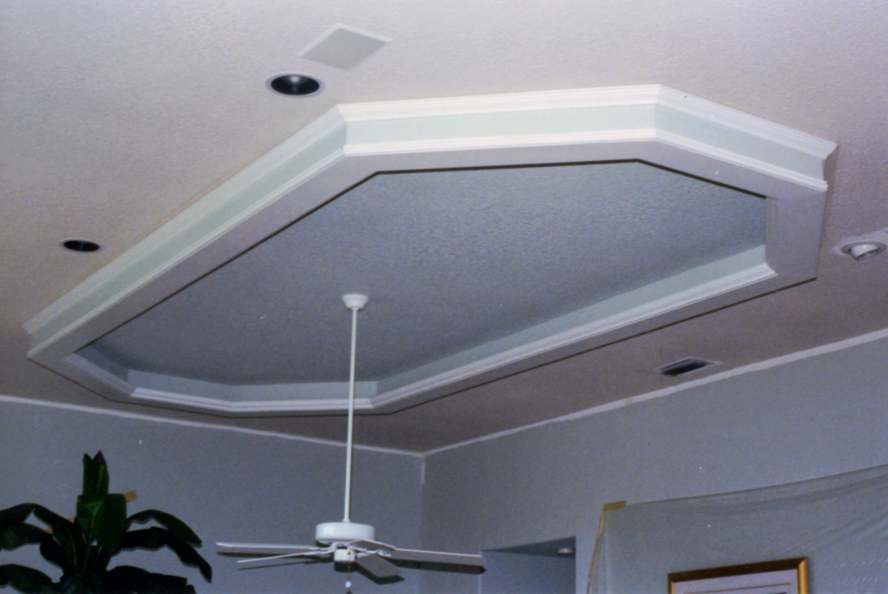Vinyl Soffit Ceiling

Vinyl soffit ceiling
Soffits are most often used on the exterior of homes or commercial buildings, as the visible finish on the underside of an overhang, porch, balcony. In essence, it is recommended to cover any exposed ceiling exterior undersurface with soffit panels, both to look great and exponentially boost the area's longevity.
What holds vinyl soffit in place?
66), each soffit panel should be fastened through the nail hem and either into the wood fascia or into a wood shim using nails, screws, or staples. To turn a corner, measure from the channel at the wall corner to the channel at the corner of the fascia board (Fig.
What is vinyl soffit?
Our vinyl soffits provide the air intake needed for proper air flow in attics, and for controlled temperatures indoors. Soffits are typically used as the exposed undersurface of the roof overhang above exterior siding. It's the ventilation support you need to protect your home from extreme temperatures and moisture.
What is a soffit in a ceiling?
Soffit ceiling is the covering that forms a ceiling on the underside of the roof in the area that extends beyond the walls of a home. Simply put, it covers the gap between the wall and the fascia, also referred to as the eave. It can also cover the underside of arches, stairways, and balconies.
How far can vinyl soffit span?
One factor is the maximum permissible span of the soffit material. Soffits usually range from 16 to 24 inches wide. For instance, CertainTeed Ironmax soffits may span 24 inches without additional nailing strips, if permitted by code rules.
What is the best material for a porch ceiling?
What can I use for outdoor porch ceiling?
- Shiplap.
- Beadboard.
- Painted Wood.
- Stained Wood.
- Tin Roofing.
- Vinyl.
- Clear.
Do you nail vinyl soffit tight?
For enclosed eaves j-channel can be attached directly to the existing wood soffit. Using any of
How do you secure vinyl soffit?
6) Fasten the first section of vinyl soffit to the framing with roofing nails. Hammer the nails snug, not tight. 7) Hook the next section of vinyl soffit to the first, then nail its opposite end. 8) Trim the last soffit section on a miter saw or with snips (usually more convenient) and install it as the other sections.
How much does it cost to install vinyl soffit and fascia?
The labor costs for soffit and fascia installation can vary from contractor to contractor. Fascia installation costs range from $6 to $20 per linear foot, while soffit installation tends to be cheaper than fascia at $1 to $3 per linear foot.
Are vinyl soffits good?
Vinyl Soffits for a Customizable Look Once in place, it is easy to clean and resistant to chips and cracks, so it looks great for the long run. Since it is resistant to water, it works well in high moisture area. As a bonus, it is also a good insulator.
Are vinyl soffits better than wood?
Traditionally, soffits were made from wood, but with modern advancements, more homeowners are choosing vinyl soffits for their durability and simplified maintenance. Vinyl soffits do not require regular painting and are available in a wide variety of textures and styles to compliment your home.
What are the different types of vinyl soffit?
Available in 5 Profiles:
- D5 Solid (. 475" panel projection)
- D5 Full Vent (. 475" panel projection)
- T4 Solid (. 484" panel projection)
- T4 Full Vent (. 484" panel projection)
- T4 Center Vent (. 484" panel projection) (White Only)
Is soffit the same as ceiling?
What Is a Soffit Ceiling? The term "soffit" refers to the visible underside of any architectural piece, whereas a ceiling is officially the highest surface.
What's the difference between soffit and fascia?
An exterior soffit is located on the span beneath the rafter tails, while the fascia is the exposed horizontal band you see at the end of the rafters. These architectural elements found along the eave area do more than just add visual interest and give a finished look to your home.
Why is it called a soffit?
The word “soffit” is derived from the French language, and literally means “something fixed underneath.” It's most commonly used around a building's main roof, but soffit can also be used under porches, under arches or columns, under a flight of stairs… pretty much anything that has a visible ceiling.
What is the best material to use for a soffit?
While there are a lot of materials on the market for soffits, only fiber cement resists moisture, insect activity, cracking, chipping, and fading. This makes it a better material overall for your home's exterior.
Is vinyl or aluminum soffit better?
When it comes to comparing aluminum soffit to vinyl, aluminum soffit provides better value overall. Factoring in the cost comparison, aesthetic quality, longevity and durability of these two materials, aluminum soffit tends to be the better choice for most homeowners.
How do you join soffits together?
And this just sandwiches between the soffit. So what you got to do take a piece of soffit and cut
What is the cheapest ceiling to install?
If you're looking for an affordable option that's low maintenance and easy to install, consider a glue-on or staple-on ceiling. They're available in basic textures and elaborate designs and attach directly to the existing ceiling or onto furring strips attached to the ceiling.
What can I use for an outdoor ceiling?
One way to achieve a traditional style, and still protect the ceiling of your porch or awning from moisture is to install waterproof beadboard paneling from Allura. Moisture resistant beadboard made of fiber cement has the look and texture of real wood beadboard, but the durability of fiber cement.








Post a Comment for "Vinyl Soffit Ceiling"